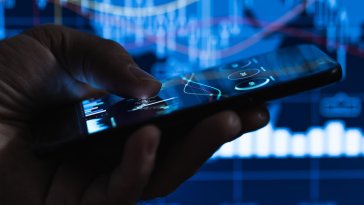
Innovation in personal health technology signals investment opportunities
Wearables and personal health technology are improving rapidly and gaining popularity, signaling investor potential.
From fitness watches to continuous glucose monitors, U.S. consumers are turning to the latest in wearable wellness and personal health products, many powered by AI innovations.
Demand rose sharply during the COVID-19 pandemic1 as people sought self-care solutions. The number of U.S. consumers prioritizing wellness continued to grow, from 42% in 2020 to 50% in 2022.2 Meanwhile, as the U.S. population ages, many older consumers use personal medical devices to manage conditions.
Global trends underscore potential investment opportunities, as the fitness tracker market has a projected CAGR of 19.1% between 2023 and 20303, and the patient monitoring device market could grow 7.7% during that period.4
- {https://www.mpo-mag.com/contents/view_breaking-news/2022-08-11/chronic-infectious-disease-prevalence-to-benefit-vital-signs-monitoring-market/;Medical Product Outsourcing (8/11/2022): Chronic, Infectious Disease Prevalence to Benefit Vital Signs Monitoring Market}
- {https://www.mckinsey.com/industries/consumer-packaged-goods/our-insights/still-feeling-good-the-us-wellness-market-continues-to-boom;McKinsey & Company (9/19/2022): Still feeling good: The US wellness market continues to boom}
- {https://www.fortunebusinessinsights.com/fitness-tracker-market-103358;Fortune Business Insights (10/2023): Fitness Tracker Market}
- {https://www.grandviewresearch.com/industry-analysis/patient-monitoring-devices-market;Grand View Research (n.d.): Patient Monitoring Devices Market Size, Share & Trend Analysis Report By Product, By End-Use (Hospitals, Ambulatory Surgery Centers, Home Care Settings, Other End Users), By Region, And Segment Forecasts, 2023 - 2030}
The longevity economy and AI are two notable growth drivers
An aging patient population is driving demand for personal health tech. Baby Boomers are a significant consumer demographic, with seniors living longer than ever. Today, retired 65-year-old couples in the U.S. can pay close to $275,000 in out-of-pocket healthcare expenses.5 These consumers are likely to spend on personal health tech designed to improve longevity and condition management.
Artificial intelligence is transforming healthcare, enabling robotic surgeries,6powering faster diagnoses7– and now powering next-generation wearables. Since AI enables predictive analytics and deep analysis, it allows for real-time pattern analysis, correlation to clinical problems, and personalized insights, helping consumers optimize their health. Investors may see a burgeoning opportunity in this tech-driven health and wellness space.
- {https://www.cnbc.com/opt-in-check/?pub_referrer=%2F2017%2F10%2F03%2Fhealth-care-dilemma-10000-boomers-retiring-each-day.html;CNBC (10/3/2017): Health-care dilemma: 10,000 boomers retiring each day}
- {https://www.facs.org/for-medical-professionals/news-publications/news-and-articles/bulletin/2023/june-2023-volume-108-issue-6/ai-is-poised-to-revolutionize-surgery/;American College of Surgeons (6/7/2023): AI Is Poised to “Revolutionize” Surgery}
- {https://linushealth.com/press-releases/blog/digital-clock-drawing-test-can-detect-alzheimers-biomarkers-in-individuals;Linus Health (4/14/2021): Digital Clock Drawing Test Can Detect Alzheimer’s Biomarkers in Individuals with No Symptoms, Study Finds}
An investor’s look at personal wellness wearables
For years, “personal wearables” just meant “step trackers.” No longer. Wearables can track all manner of interesting biometric data, and user experiences have improved, too, with gamification elements and feedback loops encouraging users to stay active, maintain nutrition, and manage stress.
No wonder that in the third quarter of 2023 alone, 150 million wearables were shipped worldwide.8The global fitness tracker market has a projected 19.1% CAGR between 2023-2030, with North America taking a 48% market share.9
Top tech market leaders have heavily invested in wearables. Apple led the wearables market in 2022 with a 29.7% share,10 launching the latest Apple Watch that can track heart rate, blood oxygen, respiratory rate, sleep, and more.11 Alphabet, Inc. (Google) acquired Fitbit in 2021, further diversifying its business ventures.12 Fitbit now powers the Google Pixel Watch, and product development continues with an upcoming AI person trainer feature.13Meanwhile, Samsung – which saw a 10-fold rise in Q1 2024 profits14 – is catching up in health tech with its Galaxy Ring health tracker expected later this year.15
Beyond the tech leaders, many other companies focusing on personal wellness wearables – and watches or wristbands aren’t the only product options.
- Garmin: Garmin’s products offer stress tracking, sleep analysis, heart rate monitoring, respiration details, and more.16 The company’s fitness segment saw a 22% bump in revenue in Q4 of 2023 and expects a 10% increase in 2024, while their stock beat predictions for Q4 2023.17
- Whoop: Valued at $3.6 billion,18 this subscription-based fitness tracker company has seen private investments from high-profile athletes.
- Oura Ring: This ring monitors over 20 biometrics, notably excelling in sleep tracking.19 Oura dominated the smart ring market in 2021 with a 52.69% share,20and recently shifted to a more competitive retail model, including selling through Amazon.21
- NURVV Run: While a small UK-based company, they have demonstrated innovation in the wearables space. NURVV Run’s smart insoles use 16 precision sensors to measure running cadence, pronation, and more to help runners improve their technique.22
- FlexoSense: Singapore start-up FlexoSense has designed smart insoles capable of tracking workplace incidents in real time for industry use,23 demonstrating the potential for corporations to leverage wearables.
By paying attention to the top market players and emerging innovators, investors can understand the competitive landscape and identify potentially promising investment opportunities.
- {https://www.statista.com/statistics/435933/quarterly-wearables-shipments-worldwide-by-vendor/;Statista (11/7/2023): Wearables unit shipments worldwide by vendor from 1st quarter 2014 to 3rd quarter 2023}
- {https://www.fortunebusinessinsights.com/fitness-tracker-market-103358;Fortune Business Insights (October 2023): Fitness Tracker Market}
- {https://www.statista.com/statistics/515640/quarterly-wearables-shipments-worldwide-market-share-by-vendor/;Statista (2/13/2024): Market share of wearables unit shipments worldwide from 2014 to 2022, by vendor}
- {https://www.apple.com/healthcare/apple-watch/;Apple (n.d.): Apple Watch. Empowering your patients to live a healthier day.}
- {https://blog.google/products/devices-services/agreement-with-fitbit/;Google (11/1/2019): Helping more people with wearables: Google to acquire Fitbit}
- {https://blog.google/technology/health/google-generative-ai-healthcare/;Google (3/19/2024): Our Progress on Generative AI in Health}
- {https://www.reuters.com/technology/samsung-flags-931-rise-first-quarter-profit-chip-prices-recover-2024-04-04/;Reuters (4/5/2024): Samsung flags 10-fold rise in first-quarter profit as chip prices recover}
- {https://www.cnbc.com/2024/02/26/samsung-galaxy-ring-specs-features-release-date.html;CNBC (2/26/2024): Samsung debuts a ‘smart ring’ with health-tracking features — its first foray into the product category}
- {https://www.garmin.com/en-US/p/1057989;Garmin (n.d.): vívoactive® 5}
- {https://seekingalpha.com/news/4069679-garmin-gains-on-beating-consensus-for-q4-numbers-expects-2024-revenue-to-rise-by-10;Seeking Alpha (2/21/2024): Garmin gains on beating consensus for Q4 numbers, expects 2024 revenue to rise by 10%}
- {https://notice.co/c/whoop;Notice (4/5/2024): Whoop Stock}
- {https://ouraring.com/;Oura Ring (n.d.): Oura Ring}
- {https://www.linkedin.com/pulse/smart-ring-market-2023-structure-along-size;360 Industry Insights (9/20/2023): Smart Ring Market 2023 Structure Along With Size, Trends, Revenue, Segments, Forecast to 2030}
- {https://www.cnbc.com/2024/03/07/oura-to-sell-its-smart-rings-on-amazon.html;CNBC (3/7/2024): Oura to Sell Its Smart Rings on Amazon}
- {https://www.nbcnews.com/select/shopping/nurvv-run-smart-insoles-ncna1269954;NBC News (6/8/2021): NURVV smart insoles: A new form of wearable running tech}
- {https://techxplore.com/news/2023-02-smart-insole-mitigate-workplace-falls.html;TechXplore (2/7/2023): Smart insole to identify and mitigate workplace slips, trips and falls}
An investor’s look at wearable devices for patient monitoring, assistance, and behavior change
Wearable devices go beyond lifestyle – they have a significant role to play in healthcare.
Remote patient monitoring devices send data to healthcare providers for assessment and intervention, allowing professionals to continuously monitor patients’ vital signs, symptoms, and medication adherence while saving time and cutting costs. Remote monitoring can also offer researchers insights into clinical trials and drug trials from afar, lowering costs.24 The remote patient monitoring device market was valued at $25.32 billion in 2020 and could reach $101.02 billion by 2028.25
Patients can also adjust their own behavior based on the data from wearables. For instance, if a continuous glucose monitor (CGM) registers a spike, the patient can take immediate action to lower the number. This kind of real-time feedback loop can be a powerful way to drive healthy behaviors. Top CGM provider DexCom saw significant momentum in 2023 with its G7 product, and recent stock gains could be related to the growing prevalence of GLP-1 users.26
Other personal health devices can track medication intake patterns, send users medication reminders, and notify caregivers of missed doses. If the device detects the user didn’t take their medication, it can inform the wearer and their doctor, potentially preventing a costly complication or hospitalization.
Wearables can also include assistive devices, such as hearing aids or assistive robotics. For example, GaitQ’s Tempo collects gait information and issues vibrational cues to help people with Parkinson’s maintain a fluid, stable gait.27Other companies are creating “exoskeletons,” or wearable suits with motorized joints, to protect construction workers28– taking the concept of wearables to the next level.
Some insurance companies, like UnitedHealthcare,29 are encouraging beneficiaries to use wearables, a strategy that could help lower claims costs and improve investor potential.
- {https://www.ncbi.nlm.nih.gov/pmc/articles/PMC10337412/;National Library of Medicine: National Center for Biotechnology Information (6/27/2023): Reducing Clinical Trial Monitoring Resources and Costs With Remote Monitoring: Retrospective Study Comparing On-Site Versus Hybrid Monitoring}
- {https://www.fortunebusinessinsights.com/remote-patient-monitoring-devices-market-106328;Fortune Business Insights (February 2022): Remote Patient Monitoring Devices Market}
- {https://www.marketbeat.com/stock-ideas/dexcom-stock-gains-from-glp-1-diabetic-users/;MarketBeat (4/2/2024): DexCom Stocks Gain from GLP-1 Diabetic Users}
- {https://www.gaitq.com/product/tempo/;GaitQ (n.d.): Tempo}
- {https://www.captechu.edu/blog/exoskeletons-promising-development-construction-site-safety;Capitol Technology University (8/8/2022): Exoskeletons: A promising development for construction site safety}
- {https://unitedhealthcaremotion.com/;UnitedHealthcare (n.d.) UnitedHealthcare Motion}
Personal health wearables are a potentially lucrative frontier for investors
As the technology continues to evolve, consumer demand for wearable health devices is likely to remain high, especially for older consumers and those addressing health conditions. These devices offer financial benefits for the healthcare system and insurance companies, too. Investors who recognize the growing significance of personal healthcare technology stand to support the rise of an important and lucrative industry.
Disclaimer
Este documento ha sido emitido por AXA IM México, S.A. de C.V., (“AXA IM Mexico”) un asesor financiero independiente constituido de conformidad con la Ley del Mercado de Valores. La información aquí contenida es consistente con las disposiciones contenidas en el artículo 6 de la Ley del Mercado de Valores, de conformidad con las disposiciones del Artículo 226, Sección VIII del mismo ordenamiento legal.
Este documento y la información contenida en este documento están diseñados para el uso exclusivo de clientes sofisticados o inversionistas institucionales y/o calificados y no debe ser dirigido hacia clientes minoristas o inversionistas particulares. Ha sido preparado y publicado con fines informativos únicamente a solicitud exclusiva de los destinatarios especificados y no destinado a la circulación general entre el público inversionista. Es estrictamente confidencial y no se debe reproducir, distribuir, circular, redistribuir ni utilizar de otra manera, total o parcialmente, de ninguna manera sin el consentimiento previo por escrito de AXA IM Mexico. No está destinado a ser distribuido a ninguna persona o jurisdicción para la que esté prohibido.
En la medida de lo permitido por la ley, AXA IM Mexico no garantiza la exactitud o idoneidad de cualquier información contenida en este documento y no asume responsabilidad alguna por errores o declaraciones erróneas, ya sea por negligencia o cualquier otra razón. Dicha información puede estar sujeta a cambios sin previo aviso. Los datos contenidos en este documento, incluyendo pero no limitado a cualquier backtesting, historial de desempeño simulado, análisis de escenarios e instrucciones de inversión, se basan en una serie de supuestos e insumos clave y se presentan con fines indicativos y / o ilustrativos solamente.
Este documento ha sido preparado sin tener en cuenta las circunstancias personales específicas, los objetivos de inversión, la situación financiera o las necesidades particulares de persona alguna en particular. Nada de lo contenido en este documento constituirá una oferta para entrar o un término o condición de cualquier negocio, transacción, contrato o acuerdo con el receptor del mismo o con cualquier otra parte. Este documento no se considerará como asesoría en inversión, asesoría fiscal o legal, ni una oferta de venta o solicitud de inversión en un fondo en particular. Si no está seguro del significado de cualquier información contenida en este documento, consulte a su asesor financiero u otro asesor profesional. Los datos, las proyecciones, los pronósticos, las previsiones, las hipótesis y / o las opiniones aquí vertidas son subjetivos y no son necesariamente utilizados o seguidos por AXA IM Mexico o sus compañías afiliadas que pueden actuar basándose en sus propias opiniones y como áreas independientes dentro de la organización.
Toda actividad de inversión conlleva riesgos. Debe tener en cuenta que las inversiones pueden aumentar o disminuir en valor y que el rendimiento pasado no es garantía de rentabilidades futuras, es posible que no reciba la cantidad inicialmente invertida. Los inversores no deben tomar ninguna decisión de inversión basada únicamente en este material.
Si algún fondo se destaca de manera particular en esta comunicación (el "Fondo"), su documento de oferta, prospecto de inversión o documento de información clave contiene información importante sobre restricciones de venta y factores de riesgo, debe leerlos cuidadosamente antes de realizar cualquier transacción. Es su responsabilidad conocer y observar todas las leyes y reglamentos aplicables de cualquier jurisdicción pertinente. AXA IM Mexico no tiene intención de ofrecer ningún Fondo en ningún país donde dicha oferta esté prohibida.
Para conocer la totalidad de los riesgos asociados, lea cuidadosamente el prospecto y/o el folleto de información clave del fondo.
AXA IM México, S.A. de C.V. está inscrita en el Registro Público de Asesores en Inversiones con número de folio 30054-001-(14084)-20/05/2016, asignado por la Comisión Nacional Bancaria y de Valores. Al respecto, la Comisión Nacional Bancaria y de Valores supervisa exclusivamente la prestación de servicios de administración de cartera de valores cuando se tomen decisiones de inversión a nombre y por cuenta de terceros, así como los servicios consistentes en otorgar asesoría de inversión en Valores, análisis y emisión de recomendaciones de inversión de manera individualizada, por lo que dicha Comisión Nacional Bancaria y de Valores carece de atribuciones para supervisar o regular cualquier otro servicio que AXA IM México pueda proporcionar a sus clientes. La inscripción en el Registro Público de Asesores en Inversiones que lleva la Comisión Nacional Bancaria y de Valores en términos de la Ley del Mercado de Valores, no implica el apego de AXA IM México a las disposiciones aplicables en los servicios prestados, ni la exactitud o veracidad de la información proporcionada.
AXA IM México, S.A. de C.V. conforme a la Ley del Mercado de Valores, tiene prohibido garantizar rendimientos a sus clientes sobre sus inversiones, así como recibir en depósito o custodia dinero o valores de sus clientes.
Asimismo, AXA IM México no percibe remuneraciones de parte de emisoras o personas relacionadas por la promoción de valores, ni de intermediarios del mercado de valores, nacionales o del extranjero.





